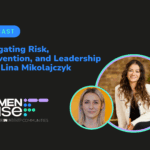Mikayla Dorney is a psychology graduate with two postgraduate certifications from Sydney, Australia. A mental health advocate who was diagnosed with ADHD in her final years of high school, Mikayla works in the cyber security team at Investigo while furthering her studies in neuroscience with the University of Adelaide. To celebrate ADHD Awareness Month, Mikayla talks to us about her experiences with ADHD and how workplaces can be more inclusive to colleagues with neurodivergences.
How did you get your diagnosis?
In every country the pathway to gaining an ADHD diagnosis is slightly different. In Australia, diagnosis seekers have to be referred by their GP to be able to even book in with a psychiatrist.
The primary problem with this system is that often GPs have minimal experience with mental health, the extent of their experience often coming in the form of one semester unit during university studies. Keeping the diagnostic pathway in mind, GPs act as the gatekeepers to getting a specialist opinion. In my case I have been fortunate to have a lovely GP who took up extra postgraduate research into mental health, but not everyone has this privilege.
Another problem is that psychiatry sessions are expensive and, at least in Australia, cannot be subsidised. On average, a diagnosis appointment will cost over $300AUD, which equates to around £160. Sessions with psychiatrists are also subject to lengthy wait times, the national average being six months’ wait for an appointment following GP referral.
Did it explain a lot of things about your life that you’d always wondered about?
A common misconception about ADHD is that it is expressed overtly in hyperactivity and inattentiveness, to an almost insufferable level. Most often the example of a distracted young boy running around a classroom causing havoc is used to illustrate the condition in effect.
Attention Deficit / Hyperactivity Disorder (ADHD) is a neurodevelopmental condition which presents in three expressive subtypes: Attention Deficit, Hyperactive Disorder, or a combination of both. An example of someone geared towards the Attention Deficit (AD) expression may be a consistent and ongoing experience of exhaustion, which can be attributed to the extra effort required to be fully present and attentive. Often, the inability to focus which characterises a large number of ADHD experiences can lead to negative internalised cognition – evidenced by the high statistical rate of comorbidity between ADHD and disorders such as anxiety and depression (MDD).
Being diagnosed can bring a lot of relief through explanation of many micro-behaviours which may have previously been disregarded or attributed to laziness or disinterest. For many people, ADHD looks a little different to how it is portrayed in the mainstream media. In my case, I find it challenging to watch television without multitasking. In many instances, people who experience similar expressive tendencies find relief using micro-mannerisms to satisfy this neurological itch. For example, using adult colouring books or crossword puzzles while consuming entertainment media.
What are the misconceptions people have about ADHD?
Hyperactivity and inhibited intellectual capacity are common and quite damaging misconceptions about ADHD. Often when the condition is misunderstood, it is assumed that ADHD individuals are fundamentally disinterested, lazy or distracted.
Misconceptions like these are arguably the result of a lack of knowledge into what differentiates ADHD brains from “normal” brains. To elaborate, ADHD is a neurological condition whereby the brain simply operates in a different way to the predisposition of non-ADHD individuals. A corporate professional working with ADHD may find their expression best managed by working in incremented blocks, for example thirty to forty minutes, then taking a five minute break to give their brain a breather. This not only strengthens the quality of work produced, but also serves to alleviate the stress that often comes with trying to force focus for long periods of time, to no avail.
Do you think ADHD in women is something that’s gone particularly under the radar?
Recent research into the neuro-biological-genetic foundations of ADHD has indicated that the genetic link between ADHD mothers and ADHD offspring could be stronger than that of the ADHD father passing the gene down. The implication is that contrary to historical belief, women may be at a genetically higher risk than men of developing ADHD. Furthermore, this finding could imply that previously reported statistical rates comparing men and women with ADHD may not be indicative of the true data.
It is important to recognise that through media like TikTok and Instagram, mental health advocacy has never been more popular. ADHD is arguably one of the most popular conditions on the internet at the moment – which has both positive and negative implications.
Positively, increased accessibility to mental health information is an exciting use of social media which serves to reduce the stigma previously attached to diagnosis. This shows promise for the future of the mental health industry and the number of people seeking support in times of need.
In contrast, increased accessibility has also led to a significant increase in misinformation, which is spread rapidly by the nature of these social media platforms. Quite obviously, misinformation can be incredibly damaging not only to the individuals with a condition, but also to impressionable minds who may self-diagnose.
Fundamentally, ADHD is a neurological condition whereby the brain has a different neuro-composition to a “normal” brain. It is important that people do not attribute situational experiences of (for example) high energy and distractedness to a neurodevelopmental condition, as this can be entirely dismissive of people who have a genuine neurodivergent condition.
Although naming neurodivergences can aid our understanding, is there a danger in giving people labels at an early age?
Ultimately, not one person on this planet thinks in a cognitively identical way to the next. Gaining a diagnosis for a disorder is only important if the individual feels as though their symptoms inhibit their daily functioning to the point of causing obvious disruption and negative cognitive detriment (i.e. stress).
In the case of ADHD, many people go their entire childhood not gaining a diagnosis, only fully appreciating the symptoms in early adulthood. At this point, significant research has found that these individuals have already developed coping skills for managing their expression of the condition. In this instance, it’s not really something that a lot of people notice majorly in their everyday life but rather in unplanned or high pressure or stress inducing situations.
Does positioning a neurodivergence as a ‘superpower’ create misconceptions or is there value in it?
Often you will find that when working on something they’re passionate about, people with ADHD are incredibly driven and motivated. This does not mean that this passion induced motivation is subject to burnout, but rather, it can actually be present throughout an ADHD person’s entire life. Presented with a topic or area of interest, such as a field of study or area of work, these individuals can form incredibly successful careers due to their neurological disposition for increased energy and hyper-attentivity. Furthermore, their neurological difference may indicate that they are thinking at a more rapid speed, therefore generating ideas quicker that a “normal” brain. Evidently, I’m of the opinion that ADHD can be a massive asset.
Emotionally, people with ADHD are often quite charismatic, animated and resilient. They are excitable, hopeful and passionate. Research supports the idea that people with ADHD are more sensitive to the emotions of their peers, resulting in being more responsive to those who may need support.
What can a workplace do to be more inclusive for people with ADHD?
Education is perhaps the most obvious but important method to inclusivity in the workplace. Evidently, as was touched on before, most ADHD individuals working in corporate spaces have already adapted coping skills for management of their symptoms. However, workplaces can certainly be an asset by familiarising themselves with the condition and understanding it as an asset rather than a burden or a detriment. Being open minded and possessing an overt willingness to learn are obvious core skills in good leaders, and encouraging these in the workplace can go a long way in supporting neurodivergent individuals.
Mikayla runs a mental health platform, Saturday Sun Psychology, which aims to make psychoeducation and positive mental health more accessible. You can find it on Instagram (@saturdayysunn), WordPress (saturdaysunpsychology.wordpress.com) and LinkedIn (@Saturday Sun Psychology).
Neurodiversity is a key focus in The IN Group’s approach to DEI, which aims to ensure we provide an inclusive workplace where everyone is given the support they need to thrive. Find out more about the work we’re doing on DEI here.
Share this:
Posted:
Author:
Tags:




